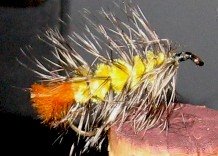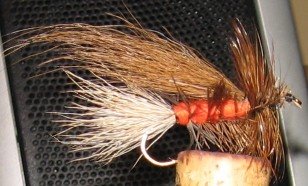The Woolly Worm: simple and effective when you aren't sure what's about to hatch. Take these in different colors for opening day in Yellowstone Park. Green, black or brown are popular, - we use a yellow one and do just fine.
This is an old fly with an heritage that is richer than it's current popularity would suggest. You can buy the conventional ones from "THE ENGLISH FLY FISHING SHOP" Their on-line catalog is extensive, informative, and reasonable. The quote below is an example of their thoroughness.
-- "Dressing a fly by winding the hackle the length of the body is mentioned in fly fishing books of the fifteenth century. It is called the palmer style of dressing. About the time Napoleon was fighting the British in France and Spain, palmer flies were being praised in books as the first fly to be used until a hatch was observed. The palmered hackle helps suggest to the trout that the fly is alive by its movement."
-- "As the British Woolly Worm palmered fly dressing style crossed the Atlantic ocean and prospered in North American rivers its popularity back home nose dived. In the 1930's the West Yellowstone fly fisher Don Martinez started to use it for trout where where previously it had been a bass fly. In his book he suggested that it was used as an attractor lure fished deep and twitched to suggest movement and life. Since then many different variations have been tied. They have been fished as nymphs, streamers and wet flies. Fishermen have used them to imitate damsel fly nymphs, leeches, scuds, stoneflies, caterpillars and cased caddis nymphs."
Marcella's Trout Fly: a regional favorite, older than most of it's fans. Start tying these now & don't get caught short when the big bugs arrive.
Courtesy of Marcella Oswald.
It's not too early to start tying flies for later in the season. One that has been forgotten on the national scene is still very much alive in Eastern Idaho, and South-Western Montana is "MARCELLA'S TROUT FLY." It is a precursor of the sofa pillow and other similar flies. It was originated by Marcella Oswald a good many years ago, (back then it was a favorite on the Trude Ranch.) We started fishing it in the 60's and it was well established then. We really enjoy using these indigenous favorites, and encourage others to do the same. Both of these flies are palmered, and very easy to tie. They are effective, productive, and use common materials. If they are no longer in fashion, it's not their fault. These two flies have been so successful and have been around for such a long time that there are many variations in the ingredients. The ones we use are listed below.
Recipe for "Woolly Worm:"
Tail: short orange acrylic yarn fibers, Body: yellow chenille, Hackle: grizzly hen - palmered from tal to head, Head: black thread. Hooks: sizes 2 - 12 standard heavy nymph, 6 - 10 2xl nymph. No special technique for fishing this attractor. Some folks grease it real heavy an let it bounce through riffles at a rapid pace with no weight.
Recipe for "Marcella's Trout Fly:"
Tail: fine deer or elk hair, Body: bright orange floss, (or wool,) Hackle: furnace cock palmered on body, furnace hen or cock at head, Wing: Moose is preferred, elk is O.K., Head black thread. Hooks: sizes 2 - 10 dry fly, 2-10 3xl dry fly. This and the sofa pillow variants, and the improved varieties can be fished just about any way that you like during the hatch. Just before and after the main swarm make sure to fish them in slow water near vegetation.





.jpg)







No comments:
Post a Comment